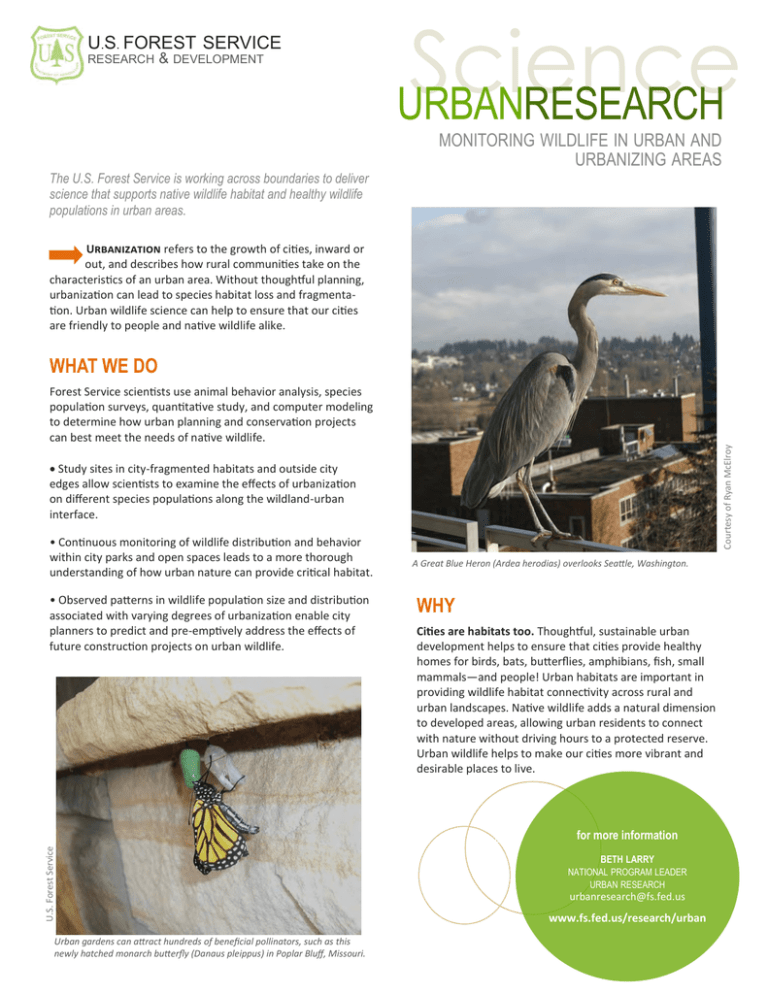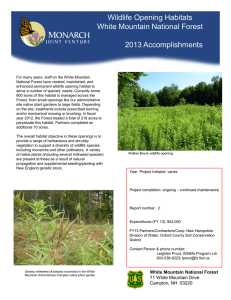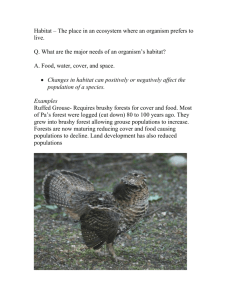Science URBAN RESEARCH
advertisement

U.S. FOREST SERVICE RESEARCH & DEVELOPMENT Science URBANRESEARCH MONITORING WILDLIFE IN URBAN AND URBANIZING AREAS The U.S. Forest Service is working across boundaries to deliver science that supports native wildlife habitat and healthy wildlife populations in urban areas. Urbanization refers to the growth of cities, inward or out, and describes how rural communities take on the characteristics of an urban area. Without thoughtful planning, urbanization can lead to species habitat loss and fragmentation. Urban wildlife science can help to ensure that our cities are friendly to people and native wildlife alike. WHAT WE DO Courtesy of Ryan McElroy Forest Service scientists use animal behavior analysis, species population surveys, quantitative study, and computer modeling to determine how urban planning and conservation projects can best meet the needs of native wildlife. Study sites in city-fragmented habitats and outside city edges allow scientists to examine the effects of urbanization on different species populations along the wildland-urban interface. • Continuous monitoring of wildlife distribution and behavior within city parks and open spaces leads to a more thorough understanding of how urban nature can provide critical habitat. U.S. Forest Service • Observed patterns in wildlife population size and distribution associated with varying degrees of urbanization enable city planners to predict and pre-emptively address the effects of future construction projects on urban wildlife. Urban gardens can attract hundreds of beneficial pollinators, such as this newly hatched monarch butterfly (Danaus pleippus) in Poplar Bluff, Missouri. A Great Blue Heron (Ardea herodias) overlooks Seattle, Washington. WHY Cities are habitats too. Thoughtful, sustainable urban development helps to ensure that cities provide healthy homes for birds, bats, butterflies, amphibians, fish, small mammals—and people! Urban habitats are important in providing wildlife habitat connectivity across rural and urban landscapes. Native wildlife adds a natural dimension to developed areas, allowing urban residents to connect with nature without driving hours to a protected reserve. Urban wildlife helps to make our cities more vibrant and desirable places to live. For For more for more information BETH LARRY NATIONAL PROGRAM LEADER URBAN RESEARCH urbanresearch@fs.fed.us www.fs.fed.us/research/urban URBANRESEARCH RESEARCH HIGHLIGHTS The value of ants. Ants stabilize ecosystems and provide key ecosystem services, including acceleration of organic material decomposition and soil aeration, both of which can improve water infiltration and productivity. Forest Service scientists studied the responses of ant communities to urbanization in the Lake Tahoe basin of the western United States. At development levels of approximately 30-40 percent, human activities had a strong, negative influence on ant species richness and abundance. The study suggests that conserving ant communities and the ecosystem services they provide might be an important target in land-use planning and conservation efforts. Sanford, M.P. et al. 2008. Effects of urban development on ant communities: implications for ecosystem services and management. Conservation Biology 23(1): 131-41. Frank Leung: iStockphoto.com Conserving avian species within the suburban landscape. In suburban western Massachusetts, the Forest Service is testing whether populations of the Wood Thrush, a declining forest bird, can persist in the face of increasing suburban development. Scientists are finding that Wood Thrush population densities, nesting success, and fledgling survival rates are comparable between suburban and more forested study sites, suggesting that establishing conservation areas in suburban areas can be an effective tool for sustaining forest ecosystem integrity across the landscape. Forest Service scientists are finding that conservation areas near urban and suburban developments support avian species such as this Wood Thrush (Hylocichla mustelina). Incorporating bird habitat into the i-Tree software suite. The Forest Service is using its i-Tree decision tool, a software suite of urban forest assessment programs, to evaluate and map the suitability of the urban forest for bird habitat. Project results will form the basis of a wildlife habitat component for i-Tree, providing an additional tool for urban forest managers and planners to quantify the many benefits of our urban forests. www.itreetools.org U.S. Forest Service Bat conservation—the importance of urban parks. The Forest Service partnered with Clemson University to investigate the effects of urbanization on bats in the southeastern United States. In a study of bat community structure across ten national park sites in rural, suburban, and ultra-urban areas, scientists found decreases in species evenness, suggesting that some bat species are susceptible to urbanization and may become locally extinct over time. The management of both rural and urban parks is thus important to bat conservation—urban parks and green spaces may serve as important refuges for rare and sensitive bat species that are not well adapted to roosting and foraging in urban environments. Studies conducted in the southeastern U.S. found that urbanization may negatively impact smaller species of bat, like this Eastern red bat (Lasiurus borealis). Loeb, S.C. et al. 2009. Relationship between urbanization and bat community structure in national parks of the southeastern U.S. Urban Ecosystems 12:197-214. helping communities transition to a sustainable future. Urban Research at the U.S. Forest Service provides leading science and decision tools to inform urban natural resources stewardship and improve environmental health and community well-being in urban areas. Our research helps to create more livable, desirable, sustainable communities. February 2013



